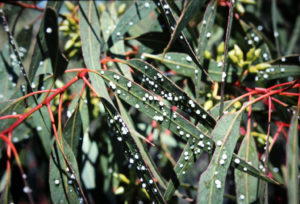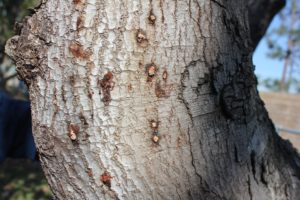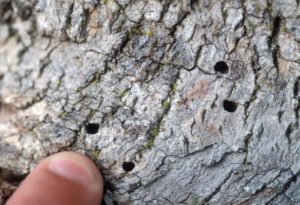Summer has arrived in Southern California and as the weather heats up you can expect to see signs of a few very pesky pests. Keep your eyes open for signs of these little guys and call your arborist if you think you might have any of them on your property.
Red Gum Lerp Psyllid
Like other psyllids, this little bug usually shows up when trees are pushing out new growth and sucks the plant phloem sap out of leaves. The Red Gum Lerp Psyllid attacks eucalyptus trees, leaving behind a sticky honeydew that causes black sooty mold, and defoliates the tree. This defoliation leaves the tree weakened and susceptible to secondary pest and disease attacks.
up when trees are pushing out new growth and sucks the plant phloem sap out of leaves. The Red Gum Lerp Psyllid attacks eucalyptus trees, leaving behind a sticky honeydew that causes black sooty mold, and defoliates the tree. This defoliation leaves the tree weakened and susceptible to secondary pest and disease attacks.
Shot Hole Borer
 The Invasive Shot Hole Borer (ISHB) is found throughout Southern California and affects over 60 species of trees. This tiny bug bores into the tree and vectors a fungus called fusarium dieback. The combination of the fungus and the pathways made by the pest weaken the tree and can cause it to fail. Signs of ISHB infestation include very small, round entry holes in the tree’s bark as well as staining, gumming or discoloration on the trunk and branches. Fusarium dieback indicators include leaf discoloration, dieback of large sections of leaves, and defoliation. In extreme cases the entire tree may fail.
The Invasive Shot Hole Borer (ISHB) is found throughout Southern California and affects over 60 species of trees. This tiny bug bores into the tree and vectors a fungus called fusarium dieback. The combination of the fungus and the pathways made by the pest weaken the tree and can cause it to fail. Signs of ISHB infestation include very small, round entry holes in the tree’s bark as well as staining, gumming or discoloration on the trunk and branches. Fusarium dieback indicators include leaf discoloration, dieback of large sections of leaves, and defoliation. In extreme cases the entire tree may fail.
Gold Spotted Oak Borer
The Golf Spotted Oak Borer (GSOB) attacks  the coast live oak, canyon live oak, and California black oak. Unlike ISHB, when this tiny bug bores into the tree it doesn’t vector a disease. Instead, it lays its eggs on the inside of the bark and the newly hatched larvae eat away at the tree from inside. The pathways the borers make as they feed disrupt the channels that move water and nutrients from the roots into the rest of the tree. If the infestation is large enough the tree will starve and die.
the coast live oak, canyon live oak, and California black oak. Unlike ISHB, when this tiny bug bores into the tree it doesn’t vector a disease. Instead, it lays its eggs on the inside of the bark and the newly hatched larvae eat away at the tree from inside. The pathways the borers make as they feed disrupt the channels that move water and nutrients from the roots into the rest of the tree. If the infestation is large enough the tree will starve and die.
Don’t Wait to Act
If you are concerned you might have any of these issues contact your arborist immediately for an evaluation. Plant health care solutions may be available but they are more effective if undertaken in the early stages of an infestation.
